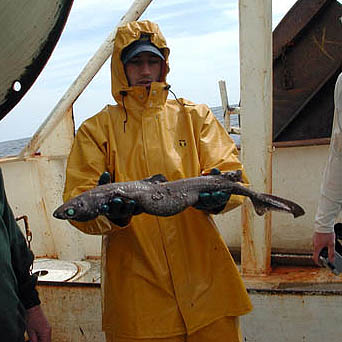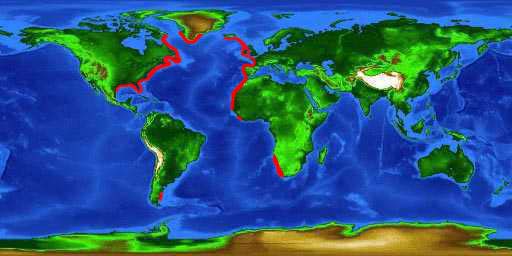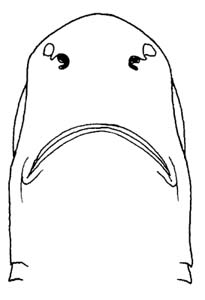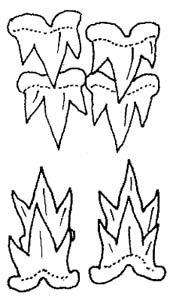Black Dogfish

Centroscyllium fabricii
This small, dark-colored shark has a stout body, somewhat small fins, and large oval eyes that are reflective green. It has two dorsal fins, each with a strong, sharp spine, and the second fin being somewhat larger than the first. Because they live at the bottom of the continental shelf or edge of the continental slope, they are not caught very often and are considered no threat to humans.
Order – Squaliformes
Family – Etmopteridae
Genus – Centroscyllium
Species – fabricii
Common Names

The English language common name for this species is black dogfish. Common names in other languages include aiguillat (French), fabricius sorthaj (Danish), svart pigghaj (Swedish), svartháfur (Icelandic), svarthávur (Faroese), tollo negro (Spanish), tollo negro merga (Spanish), and zwarte lantaarnhaai (Dutch).
Importance to Humans
Although black dogfish are occasionally taken in large numbers in deepwater bottom trawls, they are not abundant enough to support a commercial fishery. Some may be returned to port and used in processing fish meal.
Danger to Humans
The black dogfish poses no danger to humans.
Conservation
> Check the status of the black dogfish at the IUCN website.
The IUCN is a global union of states, governmental agencies, and non-governmental organizations in a partnership that assesses the conservation status of species.
Geographical Distribution

The range of the black dogfish in the western North Atlantic from Baffin Island and Greenland south to the Gulf of Mexico and in the eastern North Atlantic from Iceland south to Senegal and Guinea to Namibia. This species has also been observed off southern Argentina in the western South Atlantic.
Habitat
Black dogfish are primarily a deepwater, benthic species usually confined to the outer continental shelf and the upper continental shelf. However they have been occasionally taken near the surface in arctic waters and during periods of maximum cold and darkness. They haven been collected from as deep as 5,250 feet (1,600 m) and temperatures as low as 34°F (1°C), but are most common at 1,800-3,280 feet (550-1,000 m) and temperatures of 38-40°F (3.5-4.5 °C). Some sexual and size segregation, schooling, and spring-winter inshore migration may occur.
Biology

Distinctive Features
The body of the black dogfish is moderately stout and compressed with a short caudal peduncle and a long abdomen. The snout is moderately long with an arched mouth. The second dorsal fin is much larger than the first dorsal fin and originates over the midpelvic base. Both dorsal fins have prominent, grooved spines. The anal fin is absent. The pectoral fins are adpressed and fall short of the first dorsal fin origin.
This species may be confused with the great lanternshark (Etmopterus princeps), however they differ in lower tooth shape (multicuspid vs. blade-like) and the origin of the second dorsal fin (at level of midpelvic base vs. near posterior pelvic base). They are distinguished from the spiny dogfish (Squalus acanthias) in having deeply grooved dorsal spines (vs. rounded), in placement of the second dorsal fin (origin near rear pelvic base inSqualus), and in tooth shape (bladelike in both jaws in Squalus).

Coloration
Adult and subadult black dogfish are uniformly blackish brown without any obvious black markings above the pelvic fins, ventrally on the caudal penduncle, or laterally on the upper caudal lobe. Juvenile black dogfish are dark black ventrally and lighter black to brown dorsally with white-edged dorsal, pectoral, and pelvic fins. Spines are white in all sized of black dogfish. The eyes are a reflective green when first caught.
Dentition
The upper and lower teeth are numerous and similar in shape with a single large, erect cusp, and two (occasionally four) smaller, erect cusplets. The upper and lower jaws each consist of 68 teeth.
Dermal Denticles
Denticles of the black dogfish are close-set. They are short and conical with hooked cusps and ridged, stellate bases. Thought to be bioluminescent, the skin contains minute, deeply pigmented dots similar to those seen in other luminescent squaloid species.

Size, Age & Growth
Black dogfish reach a maximum length of approximately 35 inches (90 cm), however they are common as adults at lengths of 23.6-29.5 inches (60-75 cm).Food Habits
Black dogfish consume cephalopods, benthic and pelagic crustaceans, euphasiids, schyphozoans, and fishes, including small redfishes (Sebastes).
Reproduction
Size at sexual maturity is about 550 mm total length (TL) in male black dogfish and 650 mm TL in females. Litter size is 4-40 in this ovoviviparous species with development of the embryos dependent solely upon yolk reserves. At birth, each pup measures approximately 6 inches (15 cm) total length. The smallest free-swimming specimens to be observed measured 16.5 cm for males and 17.5 cm TL for females. Observations have shown no defined breeding season to exist for the black dogfish.
Predators
Potential predators include large fish and sharks residing in the same habitats and depths as the black dogfish.
Parasites
A copepod, Albionella fabricii n. sp., has been reported as a parasite on the gills of the black dogfish Centroscyllium fabricii caught off the west coast of Newfoundland. Also, specimens of the mesoparasitic barnacle, Anelasma, were found attached to black dogfish taken from waters off Greenland.
Taxonomy
This species was originally described as Spinax fabricii by Reinhart in 1825. This name was later changed to the currently valid Centroscyllium fabricii (Reinhart 1825). There are no known synonyms appearing in past scientific literature. The genus name Centroscyllium is derived from the Greek, kentron which means “sting” and the Greek, skylla which means “a kind of shark”.
Prepared by: George Burgess and Cathy Bester